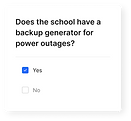top of page





SafeS - Disaster Preparedness Accreditation Service
SERVICE DESIGN
RESEARCH
SERVICE BLUEPRINT
GRAD STUDIO PROJECT


August 2024- Dec 2024 I Atlanta, Georgia
PROJECT OVERVIEW
This project aims to bridge gaps in school disaster preparedness.
Done under the guidance of Professor Florian Vollmer, Service Design Lead at Autodesk and collaboration with Capita, an independent think tank and community.
PROJECT CONTEXT
Global warming and the rise of unpredictable disasters, both natural and man-made, demand better preparedness in child-centric institutions. Many schools lack engaging programs, effective teacher training, and safe, accessible infrastructure to equip students and staff for emergencies.
PROBLEM STATEMENT
Schools are underprepared for the increasing threat of unpredictable disasters. Current programs fail to engage students or teach practical skills, teachers lack adequate training and resources, and infrastructure often does not meet safety or accessibility standard
PROJECT ROLE
Project Manager with a 3 member team- Berkeley Chandler and Sam Beagle
Infrastructure meets safety and accessibility standards
Age-appropriate disaster training for students
Well-trained teaching staff


A nationwide initiative that standardizes disaster preparedness in U.S. primary schools.
WHAT
It is designed for school administrators, teachers, and students to improve safety and readiness.
WHO
It ensures schools are equipped with.
SafeS can be used year-round for training and preparedness, with accreditation requiring annual renewal after the initial certification.
WHO
HOW IT WORKS






Disaster Preparedness Accreditation Service

Service Walkthrough


STEP 1
Service Introduction
Learn About the Service - Schools can explore the benefits of SafeSchools Accreditation on our website, including details about training programs, safety audits, and badges.


STEP 2
Registeration and Onboarding
Schools register on the platform and complete an onboarding process, answering location-specific questions about potential disasters and safety requirements.




STEP 3 ( Badges can be earned in any order )
Select Desired Badges to earn
Following Badges can be earned, earning all Badges determines the fuil accreditation






STEP 3 - BADGE 1
Infrastructure Auditing
Following Badges can be earned, earning all Badges determines the fuil accreditation
STEP 2
STEP 4

Upload Supporting Media
Submit media (photos, documents, or videos) as proof of compliance and infrastructure readiness.
STEP 1
Schools need to Complete a Checklist
Confirm your school’s disaster preparedness measures by answering a series of detailed questions.



Infrastructure Readiness Badges
🥇 Gold: Fully compliant and inclusive.
🥈 Silver: Partially compliant and inclusive.
🥉 Bronze: Compliant but not inclusive.
❌ Rejected: Must reapply after addressing feedback.
STEP 3
On-Site Audit
A certified auditor will visit your school to verify preparedness measures, ensuring they meet safety standards and accessibility requirements.





STEP 5
Flex your Badge
Accredited schools are listed on our website and can display badges publicly.
STEP 3 - BADGE 2
Teacher Training Certification
These badges not only highlight your school's infrastructure preparedness but also enhance teachers' qualifications and readiness to handle emergencies.
STEP 1
Register Faculty
Schools register all faculty members for training.


Gun Violence



STEP 2
Training modules for certifications
It will cover topics like disaster response and medical aid
Accessibility Safety


STEP 3
Earn Badges and add to Resume as well!
Teachers earn certifications/Badges that can be added to resumes, while schools earn collective badges for completed training levels.




STEP 3 - BADGE 3
Collaborative Children’s Disaster Training - Role Playing experience
Immersive Learning. Learning by doing and not just listening
STEP 3
Book a Field Trip:
Schedule a trip to a selected partner venue for hands-on training.
STEP 1
Register
Schools register primary school classes, specifying grades and student numbers.
STEP 2



View Nearby Partner Venues
Schools receive a curated list of nearby partner organizations (e.g., KidZania, Disney World, local interactive venues) in collaboration with the program, where disaster role-playing experiences are available.

Florida
Texas
STEP 4
Role-Playing Scenarios
Students engage in interactive role-playing activities tailored to local disaster risks.



STEP 5
Class Recognition:
Each class earns a Completion Badge, Kid's are awarded a keepsake as well

_edited.png)

" I love this idea of teaching our kids through play"
STEP 6
School Accreditation:
Once all classes complete training, the school receives a Schoolwide Disaster Training Badge.
This prestigious recognition highlights the school’s commitment to disaster preparedness and safety, and it will be prominently displayed on both the school’s website and the SafeS platform.
FINAL
Final SafeS Accreditation
Schools that earn badges for all three categories will be officially accredited with the SafeS Accreditation.



" We just moved from Arizona to Florida, so I’m searching for schools that are best prepared to not only look after my kids but also teach them the right tools in case of another hurricane. SafeS Accreditation makes that decision so much easier."
- A Fictional Mom, but her perspective could be a reality with SafeS in place.
BONUS SERVICE
Victim Support Services
A specialized service offering on-campus support for students, teachers, and staff affected by disasters.

Mental Wellbeing
Schools can schedule appointments for campus visits from expert teams, including trauma therapists, counselors, and disaster recovery specialists, to address emotional, psychological, and logistical needs, ensuring comprehensive care and recovery.



BONUS SERVICE
Disaster Preparedness Resource Bank
A comprehensive hub for school administrators and teachers offering safety guidelines, government policies, insurance info, and educational materials to enhance disaster readiness.

Safety Infrastructure Guidelines
Best practices for disaster-proofing school buildings.

Government Policies & Regulations
National and local guidelines on school safety. Building codes and emergency management requirements.
Insurance & Funding Information
Details on disaster insurance policies.
Grants and funding opportunities for safety upgrades.
Current News & Trends
Updates on disaster preparedness trends, emerging risks, and recent incidents to keep schools informed.






VALUE CREATION
Why should schools choose SafeS (besides the obvious)
Improved Reputation and Enrollment
SafeS Accreditation differentiates schools, attracting more families who prioritize safety in their choice of institutions.
Lower Insurance Costs
Accredited schools may qualify for reduced insurance premiums by demonstrating proactive disaster readiness.


Cost Savings Through Preparedness
Proactive disaster readiness minimizes long-term costs associated with recovery, repairs, or lawsuits after disasters.
Compliance and Risk Mitigation
Helps schools meet or exceed safety and accessibility standards, reducing liability and potential legal issues.
Building Trust and Confidence
Accreditation badges signal a school’s commitment to safety, instilling confidence among parents, staff, and the wider community
Enhanced Safety and Preparedness
Provides schools with standardized, engaging training that equips students, teachers, and administrators with practical skills for emergencies.

_edited.jpg)
HOW AND WHY WE NEED THIS SERVICE
Research Breakdown
Several rounds of research were conducted to understand the gaps in disaster preparedness and inform the design of the SafeS service
How might we improve training to ensure effective disaster preparedness at child-centric institutions?
1.
Identify and Narrow down focus area
Identify Problem areas and Oppurtunities in the space of disaster prepardeness in child centric Institutions.



2.
Secondary Research
Key Statistics and Insights based off Literature review

360,000
students have experienced gun violence at school since 1999 (in the US)


21 states
and the District of Columbia fail to meet basic emergency planning requirements for schools and childcare providers.
28 Climate
related disasters
disasters directly impacted schools in 2023, including hurricanes, floods, and wildfires

300 disasters
major disasters were declared across the U.S. from 2017 to 2019, impacting more than half of public school districts


As of 2021-22
most public schools have written plans for emergencies, but their implementation and updates vary widely across districts.
67% of all students
across the country were affected by presidentially-declared major disasters from 2017 through 2019, impacting over 54% of public school districts.
3.
Current Trends and patterns
How are kids being taught in school today.
Hands-On Drills: Schools conduct regular emergency drills
focus is on basic training for teachers and letting them talk to kids
Professional Talks with Firefighters and Emergency Personnel
Videos and Recordings (outdated)
92% of schools have an all-emergency preparedness plan
Nearly 100% of those are outdated formats of training
(not engaging for young kids)
Disaster Preparedness Activity Books/story books
play simple games designed by FEMA
4.
Ecosystem Mapping
Identifying key actors and themes
.png)
5.
Primary Research
4 Sets of interviews were conducted -
-
4 Children between the ages of 9-12
-
3 Parents
-
4 Teachers
-
1 office administrator




Data Simplification
7.
Persona Mappping
4 Personas were designed (click to view)
2 kids, 1 Parent, 1 Teacher

Interview Guide
6
Key Insights
Safety Reassures Everyone: Parents, teachers, and students prioritize visible and actionable safety measures.
Interactive Learning: Hands-on activities, games, and simulations make training more engaging and effective.
Clear Communication: Parents value transparency and updates about safety plans and drills.
Inclusivity Matters: Protocols must address the needs of all students, including those with disabilities or language barriers.
Empowerment Through Preparedness: Involvement in training boosts confidence and reduces anxiety for students and staff.
Emotional Support Needed: Post-disaster counseling and trauma resources are essential for recovery.
Collaboration Strengthens Impact: Community and peer collaboration enhance preparedness and response.
8.
Empathy Mapping
For 4 of the participant (Click to expand )
9.
Journey Maps (As- Is)
Three As-Is Journey Maps: Captured the current experiences of students and teachers during disaster preparedness activities, highlighting pain points and opportunities.
Consolidated To-Be Map: Synthesized insights from all three journeys into a simplified, streamlined future process for improved disaster preparedness.




10.
Ecosystem Mapping
Identifying key actors and themes
.png)
11.
Market And Trend Analysis
Focused in the Space of Disaster Preparedness Training at Schools
( Click to expand )



12.
Final Insights
After Synthesizing all the data, final insights were drawn
Lack of Educational Resources designed for Young Children - lack of inclusivity
Young children lack age-appropriate resources on emergencies, leaving them unprepared and anxious during disasters.
Child learn best through interactive activities. Learn through Play
Teachers and staff lack sufficient training in disaster preparedness, leading to slow response times and inadequate support for children.
Research indicates that many U.S. schools face challenges in meeting safety and accessibility standards, which can compromise the well-being of students and staff during emergencies
Lack of Standard Disaster training Protocols
HOW AND WHY WE NEED THIS SERVICE
Problem Statement
Many schools lack engaging disaster preparedness curricula that teach children practical skills for real-life emergencies. Existing programs often fail to capture young learners' attention, creating a disconnect between the material and its relevance. Teachers also receive minimal training beyond basic drills, hindering their ability to facilitate meaningful discussions and hands-on activities. Additionally, many school infrastructures fail to meet safety and accessibility standards, leaving students and staff vulnerable during emergencies.

.webp)
OUTCOME
Proposed Solution
The SafeS Disaster Preparedness Accreditation Service , a nationwide initiative that standardizes disaster preparedness in U.S. primary schools.


Check out the To-Be Map, Business Model Canvas and Concept validation workshop below
HOW AND WHY WE NEED THIS SERVICE
Synthesized To-Be Map

BUSINESS MODEL CANVAS- BMC
Business Model Canvas (BMC)
A structured framework outlining how SafeS delivers standardized disaster preparedness solutions to schools, ensuring safety, compliance, and trust among stakeholders.

( Click to Expand )
Feedback with School administrators and Parents
Concept Validation
As part of the SafeS disaster preparedness service development, we conducted a virtual workshop via Zoom to present and validate our proposed solution. The goal of the workshop was to gather valuable feedback from key stakeholders, including parents and teachers, to refine our approach and ensure it aligns with their needs and expectations
.png)

With all the fear surrounding gun violence in schools, it’s comforting to see a program that prioritizes safety and proactive training. Knowing my child’s school is equipped and prepared for these situations helps ease my anxiety as a parent. It would be great to see how the curriculum could also include some training for parents, so we can better support our children during emergencies.
"
"
- David, Parent to a 10 year
The accreditation badges make such a difference. It shows that the school takes safety seriously, and as a parent, that level of accountability is so reassuring
"
"
-Betty, Parent to a 8 year old


This solution addresses the gaps we’ve been struggling with. The interactive training modules are not only engaging for students but also give me the confidence to lead effective disaster preparedness lessons.
"
"
- Taylor, Primary School teacher

bottom of page








